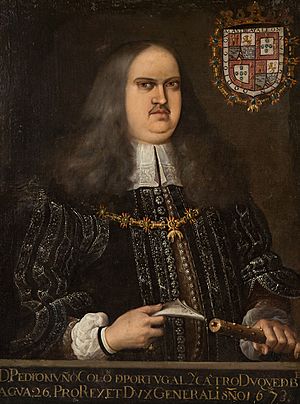Pedro Nuño Colón de Portugal, 6th Duke of Veragua facts for kids
Quick facts for kids
Admiral of the Ocean Sea
The Most Excellent The Duke of Veragua
|
|
|---|---|
 |
|
| 26th Viceroy of New Spain | |
| In office December 3, 1673 – December 8, 1673 |
|
| Monarch | Charles II |
| Preceded by | Antonio Sebastián de Toledo, 2nd Marquess of Mancera |
| Succeeded by | Payo Enríquez de Rivera |
| Personal details | |
| Born | 1615 Madrid, Spain |
| Died | December 8, 1673 (aged 44) Mexico City, New Spain |
| Spouse | Isabel de la Cueva y Enriquez de Cabrera |
Pedro Nuño Colón de Portugal y Castro was an important Spanish nobleman. He was the 6th Duke of Veragua, the 6th Marquess of Jamaica, and the 6th Count of Gelves. He was born in Madrid, Spain, on December 13, 1628. He later became the viceroy of New Spain, which was a large Spanish territory in the Americas. Sadly, his time as viceroy was very short. He served from December 3, 1673, until his death on December 8, 1673, in Mexico City.
Contents
Early Life and Family
Pedro Nuño Colón de Portugal was born in Madrid, Spain. His father was Álvaro Colón de Portugal y Portocarrero. He was the 5th Duke of Veragua and an admiral. His mother was Catalina de Castro y Portugal, the 5th Countess of Gelves. His family was related to the royal family of Portugal.
Becoming a Viceroy
Pedro Nuño Colón de Portugal was a respected knight. He was part of the Order of the Golden Fleece since 1670. He also inherited important titles like admiral and governor of the Indies.
In 1672, King Charles II of Spain chose him to be the new viceroy of New Spain. A viceroy was like a governor who ruled a colony in the king's name. Pedro Nuño Colón de Portugal was the first viceroy chosen by King Charles II.
He traveled to Veracruz in September 1673. He spent some time there checking the forts. This was important because Spain was at war with France.
His Short Time as Viceroy
Pedro Nuño Colón de Portugal arrived at Chapultepec on November 16, 1673. He stayed there for three weeks because he was not feeling well.
He officially took over the government on November 20. However, he waited to start his duties. His grand entry into Mexico City happened on December 8, 1673. His rule is counted from this date. One of the few things he did was lower the prices of cacao and maize.
His time as viceroy was the shortest ever. He died on December 13, 1673, at 5 AM. This was only five days after he formally started his job. His funeral was held in the cathedral in Mexico City. His body was placed in the chapel of Santo Cristo. Some historians believe his remains were later moved to Spain. Others think they are still in the cathedral.
After his death, the government of New Spain was given to Payo Enríquez de Rivera. He was the archbishop of Mexico at the time.
His Family and Descendants
Pedro Nuño Colón de Portugal married Isabel de la Cueva y Enriquez de Cabrera. They got married on February 8, 1645, when he was 18 years old.
They had a son named Pedro Manuel Colón de Portugal, 7th duke of Veragua. He was born in 1651. Their son also became a Knight of the Order of the Golden Fleece. He later served as a viceroy in other places, like Valencia, Sicily, and Sardinia.
Pedro Manuel Colón de Portugal married Teresa de Ayala Toledo y Fajardo de Mendoza. They had a daughter named Catalina Ventura. She later married James Fitz-James Stuart, 2nd Duke of Berwick. He was a famous Spanish ambassador.
| Government offices | ||
|---|---|---|
| Preceded by Antonio Sebastián de Toledo, 2nd Marquess of Mancera |
Viceroy of New Spain 1673 |
Succeeded by Payo Enríquez de Rivera |
| Military offices | ||
| Preceded by Álvaro Colón, 5th Duke of Veragua |
Admiral of the Indies 1636–1673 |
Succeeded by Pedro Manuel Colón de Portugal, 7th Duke of Veragua |
| Spanish nobility | ||
| Preceded by Álvaro Colón, 5th Duke of Veragua |
Duke of Veragua 1636–1673 |
Succeeded by Pedro Manuel Colón de Portugal, 7th Duke of Veragua |
| Marquess of Jamaica 1636–1673 |
||
| Preceded by Catalina de Castro y Portugal, 5th Countess of Gelves |
Count of Gelves 1634–1673 |
|
See also
 In Spanish: Pedro Nuño Colón de Portugal para niños
In Spanish: Pedro Nuño Colón de Portugal para niños

